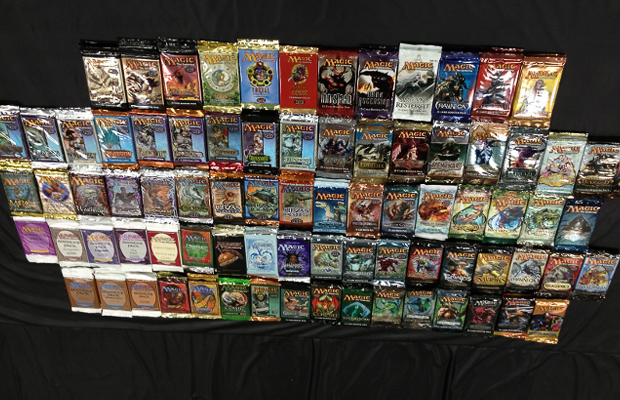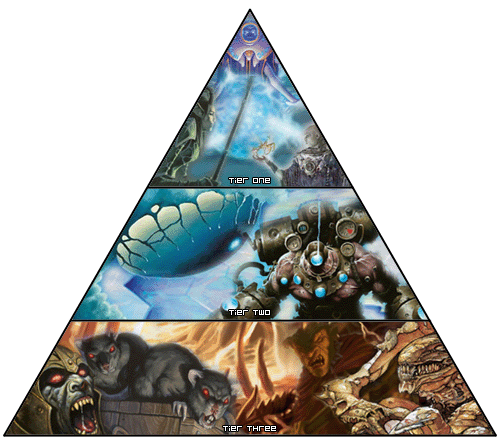A staggering amount of Magic content is published each day each day on a plethora of content sites, blogs, podcasts, and discussion forums. No matter how honest an effort you make, it's easy to fall behind and miss incredible articles because there just isn't enough time to read everything.
To that end, we've collected some of the best articles of the week covering a broad range of topics. If you're looking for articles, these are the ones you don't want to miss!
On Magic Cosplay
As Magic grows, so too does the culture surrounding it. Magic has featured some truly incredible characters throughout the years, from the likes of Urza and Gerrard all the way through the Planeswalkers that have become the face of the game today. So what happens when culture, flavor, and passion collide? Cosplay. What does it take to bring your favorite Magic characters to life? Heather Lafferty interviewed five very talented cosplayers to find out. Meet Aranel, Christine Sprankle, Jessica Caaman, Lauren Dodge, and Sonja Boschman:
GatheringMagic.com: Heather Lafferty (@Revisedangel) - The Magic of Cosplay
Jessica M. Caamano – Facebook

What is the number-one misunderstood aspect of cosplaying and people who cosplay? Many people outside of the cosplay community—or even in the convention circuit—tend to think that we're cosplaying because we aren't secure in who we are. Those people don't understand that cosplay is a hobby, just like (to others) playing a sport is a hobby.
What made you decide to cosplay Magic: The Gathering characters and cards? I gravitate toward female characters who are strong and beautiful, and that's exactly what Akroma is to me. She was the powerhouse of my Soldier/Angel deck, and opponents would always shudder when she came out to play. As I grew older and started making money, I decided to make my dream of portraying Akroma come to life.
On Becoming Vraska
So you took a look at Heather Lafferty's article about cosplay; you love the idea, but don't think you can do it. MJ Scott sets out to prove that with a little bit of time, creativity, and elbow grease, you too can bring an awesome Magic character to life. MJ gave herself just twenty four hours to transform herself into Vraska the Unseen, complete with snakes, moss, and turn-you-to-stone gorgon eyes. It sounds like a tall order, but MJ pulls it of with style. Take a look at the process from start to finish, and get started on your own Magic cosplay:
GatheringMagic.com: MJ Scott (@moxymtg) - 24 Hours to Vraska
August 30, 2013
10:00 A.M.
Finally on my way. Made mistake of trying to talk to my parents when I dropped off my son for his day with them.
Stop 1: Ross Dress for Less. Not impressed with selection of gowns at $25 and under. Made mistake of going shopping for attire w/out picture, like a total newb.
Stop 2: Toys ‘R’ Us. Bought new train toy for my son because he pooped three times in the toilet. Found rubber snakes that look awesome for $9.99 each.
Stop 3: Jo-Ann Fabrics. The devil’s playground. Discover there are such things as bulk packages of preserved moss that are perfect for Vraska’s details. As usual, there’s an insane line. Apparently, there was a coupon sale I missed out on because I don’t get the little crafty lady mailer. Oddly enough, in line with me I see a statuesque black woman dressed in Shivan brights who had just also been at Ross Dress for Less in the same section as I was. I couldn’t be mistaken—she’s six feet of hard-to-miss. Is she stalking me? She must be a Dimir spy! I don’t make eye contact and hurry to my car.
Got home and cracked a cheap tall boy. Time to get to work.

On Gods
Theros previews have started in earnest, and that means it's time to start gearing up for a new Standard. Brian is particularly fascinated with two of the Gods we've seen thus far: Purphoros, God of the Forge and Heliod, God of the Sun. How hard is it to hit five devotion? How powerful are these Gods if you can't turn them into creatures? How does the format change when Innistrad rotates? Brian tries to answer these questions and more in his explorations of the new Standard.
StarCityGames.com: Brian Braun-Duin (@BraunDuinIt) - Godlike
It's easy to look back and hate cards like Thragtusk, Bonfire of the Damned, and Olivia Voldaren because those are the cards we're currently tired of seeing. But truth be told, it was cards like those that really led to a fun, balanced, and interactive Standard environment that never grew stale even to the bitter end. In fact, none of those cards saw much play immediately. It took some time for people to catch on.
With that being said, I'm just as excited as everyone else for Theros. I loved Innistrad, and I'm not ashamed to admit it. But I also love change, fresh cards, and new experiences in Magic. I'm ready to let Innistrad go and jump feet first into a new Standard format where anything could happen.
This week Chris VanMeter and I had a chance to try out some new Theros cards in our Versus video for this Friday. It was pretty exciting to get to try out new stuff, and I was blown away by how awesome some of the cards were. Not only do they have amazing flavor, but they are just fun to play with as well.
I'd like to touch on some of the cool cards and interactions I see.
On Improvement
Magic is a difficult game. There's near infinite moving pieces, interactions, and corner cases to consider at every decision point, and it's all most of us can do to make a good choice, much less the best one. If you ask the best players in the game how to improve at Magic you'll almost always hear this proven piece of advice: "Play with better players." What if that isn't an option for you? 2011 Player of the Year Owen Turtenwald takes a look at what it really takes to step up your game, using all the resources that are available to aspiring Magic players.
ChannelFireball.com: Owen Turtenwald (@OwenTweetenwald) - Improving
This week, I wanted to write an article about something I am asked quite a bit—in fact, it might be the question I am asked most frequently by players when they first meet me: “How do I get better?”
I’ve heard people say, “it’s simple, play with better players,” but this is often a catch-22, since good players tend to only spend a lot of time playing with other good players. Today, I hope to outline the behaviors that I think are the best ways to step up your game—and if you’re serious about doing well in tournaments, then you should take these to heart.
On Drating Twenty Years of Packs
This year, Magic is celebrating it's 20th anniversary. In honor of this milestone, we saw one of the coolest events in Magic's history at Gen Con this year. If you won particular qualifier events, you made it into an 8-man draft featuring every set printed in the last twenty years, from Alliances to Zendikar. Not ony did Devin Koepke qualify for this one-of-a-kind event; he won the whole thing! Join Devin as he shares his Gen Con experience, as well as his winning strategy for this unique draft format:
LegitMTG.com: Devin Koepke - Pack City: A 20th Anniversary GenConTournament Report
This was unlike any other limited tournament I’ve ever played in before, for starters the decks had to be 60 cards out of the nine packs you chose for your sealed deck. So we wanted all playables all the time. We started throwing around ideas of the Mirrodin because the cards were easy to cast, then the Shards block because of all the fixing, and the not to shabby creatures. We actually made a list of every magic set ever and gave it a 1-10 rating scale, but we came to find that there was no better strategy than core set magic. So we settled on the mono core set strategy of 9thedition and up, however this is only our theory, and sometimes theories don’t pan out. After we settled on the way I was going to try and draft the packs I got some sushi with some friends and hurried back to the house to get ready for the big day.
As we entered the Thunderdome for the last time of the weekend, I really took it all in, the sights, the sounds, and the smells, alright- there are some things that I didn’t really want to take in but under the circumstances I was fine with it. As I start to walk over to the drafting area I see that the event isn’t going to be a walk in the park, have to dodge team Panik’s own David Gleicher, and Mana Deprived’s Josh Mcclain. Maybe I’ll get super lucky and just skip past both of them, I mean I did give a dollar to that homeless man for some nachos. As our names were called we walk to the feature match area and all we see is a table covered in packs from Beta to M14.

On Everything Pauper
Pauper is one of my favorite formats. It's high-powered, cheap to play, and the games are generally very fun and interactive. That's why I'm so excited to see JustSin produce this incredibly detailed guide to everything pauper: Introduction to Competitive Pauper - 2nd Edition. This article is thousands of words long, covering everything from kinds of events and personalities, to critical archetypes and interactions, complete with awesome graphics as well! JustSin put an incredible amount of work into this, and it really does show. If you're looking to get started playing Pauper, either online or paper, this is the best introduction you could ask for.
MTGOAcademy.com: JustSin (@MTGOJustSin) - Introduction to Competitive Pauper - 2nd Edition
I have been keeping track of the competitive Pauper scene for over a year at this point, and when the number of showings during each of these weeks is totaled, certain decks clearly stand above the rest. Based upon their average showing percentage, I have created my own tier breakdown. Often a classic tiered system will look like what I previously mentioned and focus on a tier 1 – 1.5 – 2 system, which I’ve never really been a fan of. As I like to do, I’ve simplified the idea of a tier system in order to simply illustrate the top decks in Pauper based upon popularity and strength of show.

It is important to know each of these decks. Even if you’re not planning on playing any of these decks, you’re going to encounter them in competitive play and should at least have a basic understanding of card choices and interactions within them.
On Learning by Streaming
We're all familiar with Magic streaming by now, right? If not, I suggest you head over to Twitch.tv, because you've been missing out! Streaming Magic Online and live Magic events is a new and exciting way to experience the game without having to travel or commit time or money. You can watch Limited, Constructed, or even casual Commander games featuring everyone from high profile players to other players who are just looking to learn.
One of the appeals of streaming is that you get to interact with the streamer in real-time, whether to ask questions, joke around, or troll relentlessly. Trevor Murdock, however, took streaming in a different direction. Rather than interact with his audience in real time, Trevor had a coach, Derek Boyko, critiquing his play with the livechat while he was focusing on playing. Trevor himself only received the feedback afterwards. This format forces you to look for recurring mistakes and patterns in your play, rather than listening to your coach only to revert back to your bad habits when they aren't around. What did Trevor learn about himself? Check out his new series, Judge of Currents, to find out:
Planeswalkersfordiversity.wordpress.com: Trevor Murdock and Derek Boyko (@tqmurdock, @mtgdiversity, and @HunkyFlunkie)- Streaming + Coaching = ???
Welcome to Judge of Currents, a new series where a regular Magic player streams while the audience discusses strategic commentary live with a more experienced player. What distinguishes Judge of Currents from a regular situation with feedback is that the streamer is cut off from the more experienced player and the audience, so doesn’t get the feedback in real-time, only later. We think this is a rather novel way to approach streaming. Have we broken the format? Is there a reason no one else does it this way? Let us know what you think in the comments below.
If you have suggestions for next week's recap you can mention us on Twitter, or share throughout the week in the comments below.






















